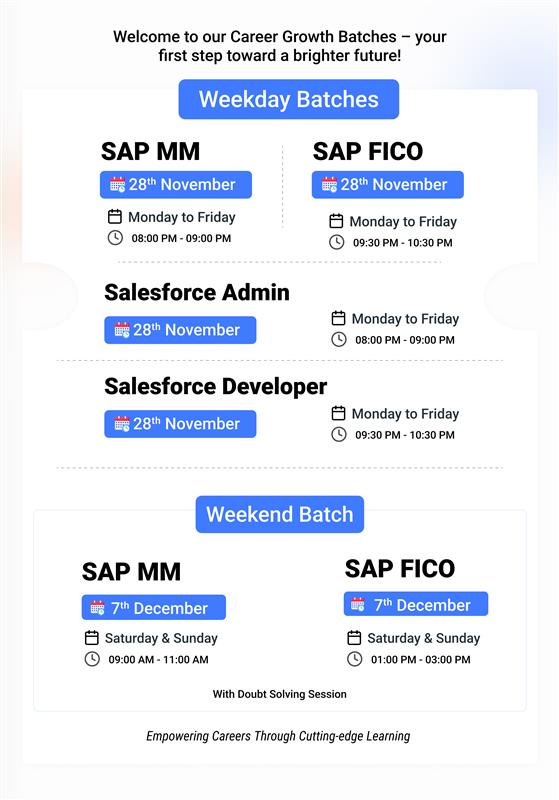Best Guide to Scheduling Agreement in SAP MM (2025) for Beginners
In 2025, organizations are increasingly focusing on long-term procurement planning to ensure uninterrupted supply of goods and materials. One of the key tools in SAP Materials Management (SAP MM) for achieving this is the Scheduling Agreement. Understanding Scheduling Agreement in SAP MM is essential for professionals working in procurement, inventory management, or SAP consulting roles.
This blog provides a comprehensive explanation of Scheduling Agreements in SAP MM, including their definition, step-by-step process, TCodes, types, examples, and related tables. Whether you are a beginner or preparing for an SAP MM job interview, this guide will help you master this important concept. For practical training and real-time project experience, GTR Academy offers detailed SAP MM courses tailored for beginners and IT professionals.

1. What is a Scheduling Agreement in SAP MM?
A Scheduling Agreement in SAP MM is a long-term purchase agreement made between a company and a vendor, specifying the supply of a particular material over a defined period under predefined terms and conditions. Unlike a standard purchase order, a scheduling agreement does not require multiple POs for repeated procurement; instead, delivery schedules are planned in advance and maintained in the system.
Key Features of a Scheduling Agreement:
-
Allows procurement planning for extended periods.
-
Reduces administrative effort compared to multiple purchase orders.
-
Improves coordination between vendors and buyers for timely material supply.
-
Ensures better price control and delivery commitment.
Understanding how scheduling agreements work is crucial for ensuring a smooth supply chain process in SAP MM.
2. Importance of Scheduling Agreements in SAP MM (2025)
In 2025, Scheduling Agreements in SAP MM play a vital role in optimizing supply chain operations. They help organizations:
-
Maintain continuous material availability without repetitive ordering.
-
Reduce manual workload by automating delivery schedules.
-
Improve vendor relationship management with predefined terms.
-
Enable efficient inventory planning and cost management.
-
Integrate seamlessly with SAP SD (Sales and Distribution) and SAP PP (Production Planning).
For IT professionals and SAP consultants, mastering scheduling agreements is essential to handle real-world procurement scenarios effectively.
3. Scheduling Agreement in SAP MM TCode
SAP provides specific transaction codes (TCodes) to manage scheduling agreements efficiently:
-
ME31L – Create Scheduling Agreement
-
ME32L – Change Scheduling Agreement
-
ME33L – Display Scheduling Agreement
-
ME38 – Maintain Schedule Lines
-
ME3L – Outline Agreement List (Vendor-wise)
Learning these SAP MM TCodes is vital for SAP consultants and end-users working with outline agreements and automated procurement.
4. Scheduling Agreement in SAP MM Step-by-Step Process
Step-by-Step Guide to Creating a Scheduling Agreement:
Step 1 – Access TCode ME31L
Use ME31L to initiate a new scheduling agreement.
Step 2 – Enter Vendor and Document Type
Provide the vendor number and choose the appropriate document type.
Step 3 – Input Material Details
Include the material number, plant, purchasing organization, and purchasing group.
Step 4 – Define Validity Period
Set the start and end dates for which the scheduling agreement is valid.
Step 5 – Add Delivery Schedule Lines (TCode ME38)
Define delivery dates, quantities, and split delivery schedules.
Step 6 – Save the Agreement
The system will generate a unique scheduling agreement number.
This structured process streamlines long-term procurement planning and enhances accuracy.
5. Types of Scheduling Agreements in SAP MM
SAP MM offers two primary types of scheduling agreements:
-
Without Release Documentation: Schedule lines are directly maintained without formal release.
-
With Release Documentation: Requires release orders to formally communicate delivery dates to vendors.
Each type serves different business use cases, depending on vendor control and documentation preferences.
6. Scheduling Agreement in SAP MM Example
Example:
A company plans to procure 10,000 units of raw material from a vendor over six months. Instead of creating multiple POs, a Scheduling Agreement is created. Delivery is scheduled monthly using schedule lines.
This ensures timely supply, reduces administrative workload, and simplifies procurement planning.
7. Scheduling Agreement in SAP SD
While SAP MM handles vendor-side agreements, SAP SD (Sales & Distribution) manages customer-side scheduling agreements.
-
SAP MM → Vendor procurement
-
SAP SD → Customer deliveries
This integration ensures synchronization between procurement and sales, improving end-to-end supply chain visibility.
8. Scheduling Agreement in SAP MM Table
SAP stores scheduling agreement data in the following SAP MM tables:
-
EKKO – Header data of the outline agreement
-
EKPO – Item-level details of the agreement
-
EKET – Delivery schedule lines
Understanding these tables is essential for reporting, analytics, and data troubleshooting in SAP MM.
9. Scheduling Agreement in SAP MM PDF and Learning Materials
Many learners prefer offline resources, and Scheduling Agreement in SAP MM PDFs are widely used. These resources typically contain:
-
Step-by-step instructions
-
TCode references
-
Common interview questions
-
Scheduling agreement examples
Downloading updated PDFs can help reinforce learning and improve retention.
10. Why Learn Scheduling Agreements in SAP MM?
Here’s why every beginner or SAP aspirant should master scheduling agreements in SAP MM:
-
Widely used across manufacturing, automotive, and logistics sectors.
-
Frequently asked about in SAP MM job interviews.
-
Builds foundational knowledge for advanced SAP procurement processes.
-
Opens doors to roles such as SAP MM Consultant, Procurement Analyst, or Supply Chain Executive.
Connect With Us: WhatsApp
Conclusion
A Scheduling Agreement in SAP MM is a powerful and essential tool that enables long-term procurement planning, reduces manual effort, and strengthens vendor relationships. By maintaining agreed quantities, delivery dates, and pricing under one document, companies ensure operational continuity and reduce procurement overhead.
In 2025, with SAP S/4HANA offering more advanced tools and Fiori-based apps, mastering scheduling agreements, TCodes, agreement types, and tables will be crucial for both beginners and professionals.
For job-ready SAP MM skills, hands-on training, and downloadable PDF materials, GTR Academy’s SAP MM course offers practical learning with real-time project exposure.


